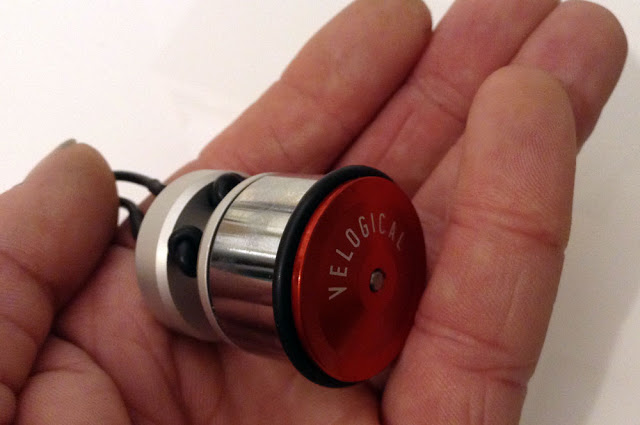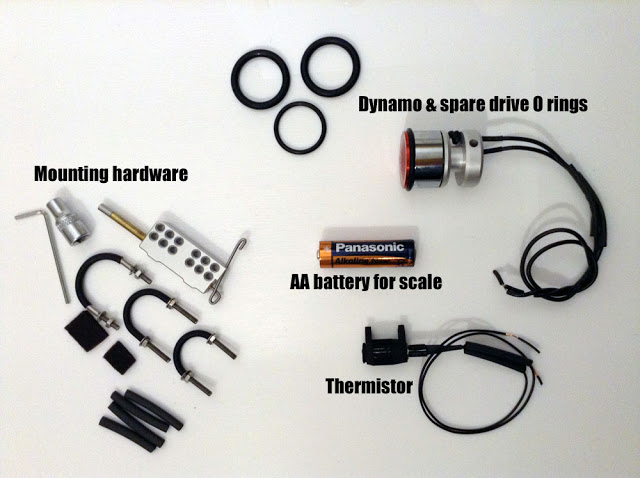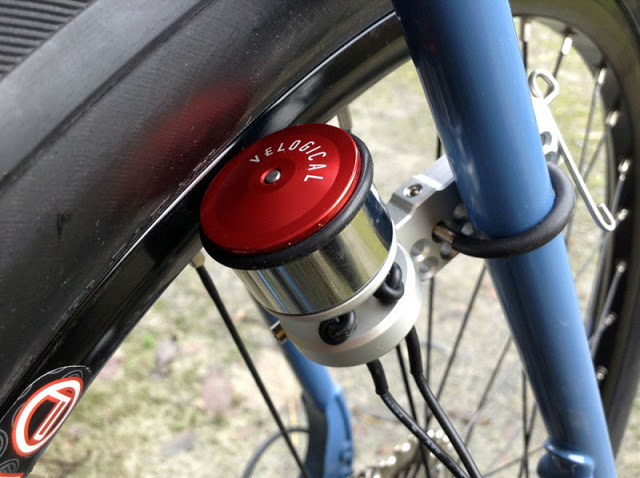 |
| No, I haven’t got massive hands, it really is that small and it weighs less than 75g. |
The Velogical isn’t like other dynamos because it doesn’t need building into a wheel. I’m loathed to call it a ‘bottle dynamo’ for fear that people may compare it to or formulate an opinion based on their experience of the thing that wore a hole in the sidewall of the tyre on their Raleigh Grifter … let’s just say, ‘the principle is similar but the execution is a thoroughly 2017, not 1917’.
I’m sure you can already see that the Velogical side-steps some of the arguments against having a dynamo – firstly, it doesn’t require a wheel build and the associated costs. If it were to break you might be left in the dark but it will have absolutely no bearing on your bike’s mechanical integrity and your ability to keep riding, it also won’t require a wheel strip to get it repaired / replaced. Should you wish to ride a 26″ wheeled bike to work but prefer 29″ at the weekend, then it’s a twenty minute job to swap it between bikes. As yet, I can’t tell you anything about reliability because I don’t know, but if finish and attention to detail are hallmarks of quality and quality equals reliability, then we should be on a good footing.
 |
| What’s in the box? Everything you need including a socket and an allen key … but not a battery. |
At first glance, fitting appears quite complicated – perhaps a thought reinforced by the very comprehensive instruction’s the dynamo arrives with. However, the reality is quite different and by the time you’ve read through everything, made a brew, familiarised yourself with the contents of the box and made another brew, you’ll be good to go. It is possible to fit the unit to either wheel and to bikes with both disc or rim brakes. In some cases you may need different fittings from the one’s I have here but that’s something you can specify when you order and something easily changed at a later date if the need arises.
Once in place, the unit feels very secure and due to its size, goes largely unnoticed. Should you wish to ‘disconnect’ it and I really can’t think of any reason why you would, a quick flick of the lever at the rear of the mount will move the dynamo away from the rim. When you get the inevitable puncture, a second ‘flick’ will move it back further still, giving you clearance to remove the wheel … speaking of wheels. As is probably now quite obvious, the Velogical is driven off the side of the wheel rim so I imagine there’s going to be a limit to just how much mud and gloop that ‘connection’ can tolerate. I really don’t envisage any problems with road, gravel or most of the bridleways and byways we choose to ride but I will endeavour to discover just how far ‘off-road’ you can venture.
 |
| 6V, 1.5w which should be plenty for modern LED lights. |
Anyone paying even a little attention has probably noticed that the top of my dynamo is anodised a lovely red colour … well, they aren’t all red. The Velogical is available in three different configurations and you can select which best suits your needs. A red top indicates the unit is a ‘sports’ model which provides minimal resistance and is well suited to speeds above 10kph. A silver top means ‘Trekking’ and produces a little more umph at slightly lower speeds. Should you anticipate riding very slowly and requiring maximum output even at those speeds, you’ll be best served with a dynamo sporting a blue cap. Aside from the cap designation, there’s no difference in physical size or weight but I do think having the option to tailor the output to your requirements is a nice touch … and yes, I know anyone I’ve ever ridden with is now wondering why I’ve got a ‘sport’ model.
For the moment, that’s all I can really tell you but the dark, cold nights are calling my name, so I shall return shivering and wet and let you know how we’re getting on. In the meantime, have a look at the Velogical website where you’ll find lots of detailed information and no doubt the answers to many questions.
These are great dynamos but I found the noise to be annoying. I think if you only want to recharge devices they are fine, but riding all night would drive me crazy. Also, you need to be careful with the rim pressure or it can damage. I am staying with my Son hub unit.
Can it be interfaced with a device to charge a battery and then power the lights, phone, etc. from the battery?
It can Nobby. As you say, it just needs a regulator such as a Sinewave, Cycle2Charge or similar and it'll supply a 5V DC supply to whatever you like.
I listen out for the noise Chris … however, I'm hoping it might drown out the constant jabber from my most frequent riding partner (hello Mike).
Thank you.
ummm.Sat here contemplating on this whole add on drive potential for dynamos to have the advantages you state. Wonder if a slim drive ring gear could be added to a disc brake using the 6 mount bolts (or even more off the wall make the disc itself with a toothed edge) then mount the dynamo to be driven from it; with a reduction gear it will run pretty fast. but I have been drinking 😉
I suggest you get your dremel out Jack ;o)
This comment has been removed by the author.